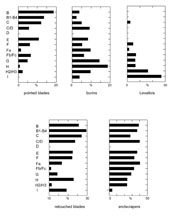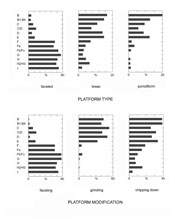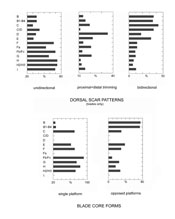Transition from IUP to Ahmarian
One of the aims of research at Üçagizli I cave was to document the transition from the Initial Upper Paleolithic (IUP) to the Ahmarian, and in particular to investigate whether the shift was abrupt or gradual. Prior to beginning work at this site the transition was iknown only at Ksar ‘Akil, Lebanon, a site excavated many years ago using relatively coarse-grained units. At least some researchers believe that the IUP developed out of the Levantine Mousterian, so the relationship between IUP and Ahmarian has relevance to questions about the MP-UP transition in the Old World. The simple fact that the IUP seems to represent the first recognizable type of Upper Paleolithic in many places does not necessarily mean that the IUP was ancestral to later UP complexes: like the Cattelperronian or the Uluzzian, it might well have disappeared “without issue.”
Overall, the cultural sequence at Üçagizli I cave is consistent with that from Ksar ‘Akil in that it suggests much continuity between the IUP and Ahmarian. However, the nature of the transition depends on the kinds of features being compared. Different elements change at different rates - some shifts are gradual, some more abrupt. Changes through time in the frequencies of different retouched tool forms are gradual and of relatively small magnitude. Changes in blank form are similarly gradual and incremental, with the main trend being the decline and eventual near-disappearance of the Levallois-like blanks.
Shifts in manufacture technique appear to be abrupt rather than gradual, by contrast, with rapid changes in the preparation of core platforms between layers F and E. Dorsal scar patterns on blades show a similarly abrupt change at the E/F boundary, reflecting a shift in emphasis in favor of platform prismatic blade cores. However, this tendency does not manifest itself in the residual cores found at the site until higher up in the sequence, in layers B1-B3 and B. This lack of synchrony between different components of chipped stone industries provides a much richer perspective on the development of early Upper Paleolithic technology in the region. At the very least it suggests that several quasi-independent technological transitions occurred within these two Upper Paleolithic complexes.


